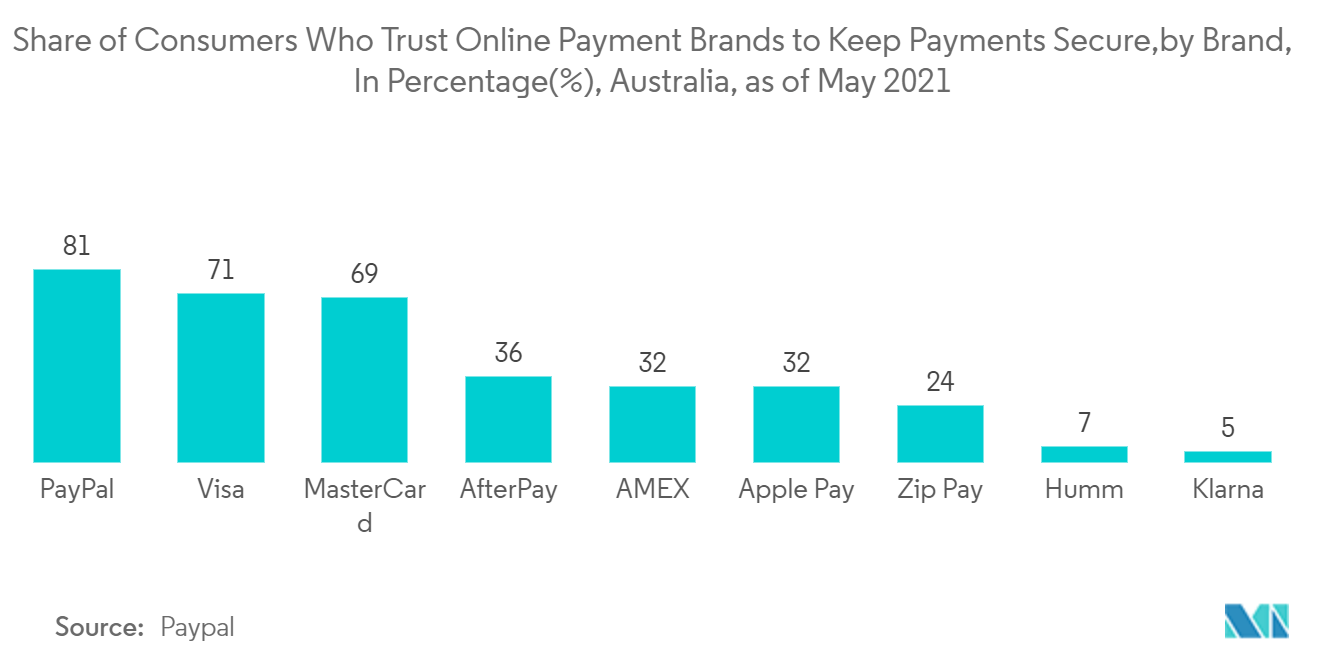Market Trends of Australia Mobile Payment Industry
This section covers the major market trends shaping the Australia Mobile Payment Market according to our research experts:
Integration with E-commerce Dominating the Growth of the Market
- With a rising number of smartphones and high-speed cellular networks in Australia, the e-commerce business is expanding. Mobile transactions are predicted to develop significantly as the E-commerce industry grows, delivering a huge boost to the mobile payments market.
- The penetration of mobile E-commerce in Australia has paved the way for the adoption of mobile wallets. According to the Australian Bureau of Statistics, in September 2021, the share of online sales in total retailing in Australia was roughly 15.3%, the highest proportion of online sales during the Feb 2020-Sep 2021. Food retailing's share of online sales declined from 7.4 % in 2020 to 7.2 % in 2021; however, online food sales were still larger than at the end of 2020(4.5%).
- According to a new survey by Marqeta, Australian consumers are at the vanguard of mobile wallet use and acceptance of digital banking tools, leaving cash and physical payment experiences in more significant numbers than consumers in the United States or the United Kingdom. The 2022 State of Consumer Money Movement study by Marqeta surveyed 4,076 people across three continents, including over 1,000 in Australia, to find out how people in the United States, the United Kingdom, and Australia want to pay, bank, and shop.
- Furthermore, according to the survey, 69% of Australians said they felt secure enough using a mobile wallet to leave their physical wallet at home, 23% more than the number of Americans who said the same. Mobile wallets received higher grades for convenience (90 %) than other survey respondents, and more Australians indicated they could make mobile payments anywhere they wished (86% ).
- According to a survey conducted by Paypal, in 2021, around 81% of consumers who shop online in Australia trust PayPal to keep their payment secure. Among the respondents, around 71% trust Visa while around 69% trust MasterCard.
- Several companies have witnessed strong growth owing to the proliferation of E-commerce in the country. For instance, Afterpay is an Australian-based company. In the financial year 2021, Afterpay had approximately 3.6 million active customers in Australia and New Zealand. The company offers a payment service that splits online purchases into four installments.

Significant Growth in Mobile Payments is Expected Due to Technological Advancement
- Mobile payment technology has evolved over time in Australia. Users were initially apprehensive about embracing Mobile NFC technology for contactless payments. Furthermore, technological improvements in credit card contactless technology have slowed the adoption of mobile payments.
- However, with the introduction of Covid-19, the adoption of mobile payments has accelerated. With many users staying at home owing to the country's various lockdowns, the use of mobile payments in retail and e-commerce has grown.
- With such a growth in mobile payment use, service providers actively invest in innovative technologies to protect and improve mobile payment performance. AI and ML, biometric authentication, and other technologies are being incorporated into mobile payment systems to improve payment security.
- Because mobile payments create huge volumes of data daily, security is a critical component of mobile payment technology. The integration of AI and ML into mobile payment technologies for fraud detection has recently risen. Banks are continually examining data generated by Machine Learning to detect fraudulent actions.
- Furthermore, many financial service providers have incorporated biometric authorization technologies, such as fingerprint, iris, retina, vein, and other forms of scanning, in recent years. Furthermore, as more clients migrate to mobile payments, financial institutions are under pressure to provide safe authentication methods, resulting in developments in biometric technology for authorization.


